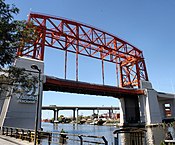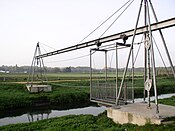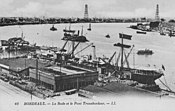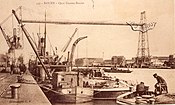Transporter bridge
This article has an unclear citation style. (September 2012) |
 An animation showing how a transporter bridge operates with vehicular, pedestrian and shipping traffic | |
| Material | Steel |
|---|---|
| Movable | Yes |
A transporter bridge, also known as a ferry bridge or aerial transfer bridge, is a type of movable bridge that carries a segment of roadway across a river. The gondola is slung from a tall span by wires or a metal frame. The design has been used to cross navigable rivers or other bodies of water, where there is a requirement for ship traffic to be able to pass. This has been a rare type of bridge, with fewer than two dozen built. There are just twelve that continue to be used today, including one converted into a lift bridge and one designed as, but not yet operating as, a transporter bridge.
History
The concept of the transporter bridge was invented in 1873 by Charles Smith (1844-1882), the manager of an engine works in Hartlepool, England. He called it a "bridge ferry" and unsuccessfully presented his ideas to councils in Hartlepool, Middlesbrough, and Glasgow.[1]
The first transporter bridge, Vizcaya Bridge was built between Las Arenas and Portugalete, Spain, in 1893. The design from Alberto Palacio[2] inspired others to attempt similar structures. The idea came about in locations where it was seen as impractical to build long approach ramps that would be required to reach a high span, and in places where ferries are not easily able to cross. Because transporter bridges can carry only a limited load, the idea was little used after the rise of the automobile.
The first such bridge built in France, the 1898 Rouen bridge crossing the Seine, was destroyed by the French Army to slow down German troops in World War II. Transporter bridges were popular in France, where five were erected and another partially completed.
The United Kingdom has four transporter bridges, though Warrington Transporter Bridge is disused and the modern Royal Victoria Dock Bridge, though designed with the potential to be used as a transporter bridge, has so far only been used as a high-level footbridge. The Newport Transporter Bridge was built in 1906 across the River Usk in Newport. Because the river banks are very low at the crossing point (a few miles south of the city centre) a traditional bridge would need a very long approach ramp and a ferry could not be used at low tide. The Newport bridge was a Ferdinand Arnodin design.[3] The Middlesbrough Transporter Bridge opened in 1911 crossing the River Tees.[1] It was featured in the 2002 series of the popular British TV show Auf Wiedersehen, Pet; the programme's plot had the bridge being dismantled and re-erected in Arizona, USA.[4] The Widnes-Runcorn Transporter Bridge, demolished in the early 1960s, was the first of its type in Britain, and the largest ever built.
In the United States, two such bridges were built. The first was the Aerial Bridge built in Duluth, Minnesota in 1905, although the city had originally planned to build a vertical lift bridge at the site. The transporter design was used for about 25 years before the structure was reconfigured to lift a central span in 1930.
The second American transporter bridge was different from other designs and partially resembled gondola lifts used in mountainous regions. The Sky Ride was part of the 1933–34 Chicago World's Fair ("Century of Progress"), it was taken down after standing for just two years. However, it was the longest bridge of this type ever built at the time.
Two historic transporter bridges survive in Germany. A unique example is the bridge at Rendsburg, from 1913 which is two bridges in one: A railroad link crosses high above on the top span, and the suspended ferry carries traffic on the valley floor. The bridge at Osten is four years older and was the first transporter bridge in Germany.
List of transporter bridges
Existing bridges
| Bridge | Image | City | Country | Completed | Span | Clearance | Height | In Use? | Coordinates | Notes |
|---|---|---|---|---|---|---|---|---|---|---|
| Vizcaya Bridge |  |
Portugalete/Getxo | 1893 | 164 m (538 ft) | 45 m (148 ft) | 61.3 m (201 ft) | Yes | 43°19′23″N 3°1′1″W / 43.32306°N 3.01694°W | In use 24/7, passenger fare 0.35 euro in 2012, declared in 2006 World Heritage Site by Unesco. Prototype for subsequent bridges. | |
| Rochefort-Martrou Transporter Bridge |  |
Rochefort, Charente-Maritime | 1900 | 140 m (460 ft) | 50 m (160 ft) | 66.5 m (218 ft) | Under restoration; reopening scheduled for 4 April 2020 but postponed due to COVID-19 outbreak[5] | 45°54′58″N 0°57′38″W / 45.91611°N 0.96056°W | In use during the summer. This bridge may be seen in the film The Young Girls of Rochefort. | |
| Aerial Lift Bridge |  |
Duluth, Minnesota | 1905 | 120 m (390 ft) | 41.1 m (135 ft) | 69.5 m (228 ft) | No | 46°46′44″N 92°5′34″W / 46.77889°N 92.09278°W | No longer a transporter bridge; converted into a lift bridge in 1929, in use. | |
| Newport Transporter Bridge |  |
Newport | 1906 | 196.6 m (645 ft) | 50 m (160 ft) | 73.6 m (241 ft) | Yes | 51°34′14″N 2°59′8″W / 51.57056°N 2.98556°W | Re-opened on 30 July 2010 after closing completely in 2008 for a £2 million restoration. Appears in the film Tiger Bay.[6] | |
| Osten Transporter Bridge |  |
Osten | 1909 | 80 m (260 ft) | 30 m (98 ft) | 38 m (125 ft) | Yes | 53°41′39″N 9°10′58″E / 53.69417°N 9.18278°E | In use, but only as a tourist attraction. | |
| Middlesbrough Transporter Bridge |  |
Middlesbrough | 1911 | 180 m (590 ft) | 49 m (161 ft) | 68 m (223 ft) | Yes | 54°35′4″N 1°13′40″W / 54.58444°N 1.22778°W | Refitted motors in 2010. Still in use, not in high winds | |
| Rendsburg High Bridge |  |
Rendsburg | 1913 | 140 m (460 ft) | 42 m (138 ft) | 68 m (223 ft) | Yes | 54°17′37″N 9°40′56″E / 54.29361°N 9.68222°E | In use, only known combo railroad/transporter bridge. | |
| Puente Transbordador |  |
Buenos Aires/Dock Sud | 1914 | 103.6 m (340 ft) | 43.5 m (143 ft) | 52 m (171 ft) | Yes | 34°38′18″S 58°21′22″W / 34.63833°S 58.35611°W | In use. It was closed in 1960 but was restored and reopened in September 2017. | |
| Warrington Transporter Bridge |  |
Warrington | 1916 | 57 m (187 ft) | 23 m (75 ft) | 27 m (89 ft) | No | 53°23′1″N 2°36′27″W / 53.38361°N 2.60750°W | Disused. Listed as an "ancient monument", but still at risk. (One of two originally at this site; the other, from 1905 did not survive.) | |
| Puente Nicolás Avellaneda |  |
Buenos Aires/Dock Sud | 1940 | 60 m (197 ft) | 21 m (69 ft) (not lifted), 43 m (141 ft) (lifted) | 57 m (187 ft) | Yes | 34°38′17″S 58°21′21″W / 34.63806°S 58.35583°W | Transporter bridge below a liftable section of a vertical lift bridge. Since 1960 only used, when the road on the bridge is closed for maintenance work. | |
| Royal Victoria Dock Bridge |  |
London | 1998 | 128 m (420 ft) | 15 m (49 ft) | 45 m (148 ft) | No | 43°19′23″N 3°1′1″W / 43.32306°N 3.01694°W | Designed to allow use as a transporter bridge but currently only in use as a high-level footbridge. | |
| Erlebnisbrücke |  |
Near Mönchengladbach | 2003 | 10 m (33 ft) | Yes | 51°14′17.1″N 6°28′28.52″E / 51.238083°N 6.4745889°E | Small human-powered transporter bridge.[7] | |||
| Hamrštejn Footbridge |  |
Liberec and Chrastava, over Lusatian Neisse | 2010 | 23 m (75 ft) | Yes | 50°47′16.5″N 14°58′13″E / 50.787917°N 14.97028°E | Small human-powered transporter bridge. |
Historic bridges
See also
- Movable bridges for a list of other movable bridge types
References
- ^ a b Lloyd, Chris (12 October 2011). "Transporter Bridge left boats in its wake". www.thenorthernecho.co.uk. The Northern Echo. Retrieved 25 October 2011.
- ^ El Gran Puente Colgante De Bizkaia
- ^ Newport Transporter Bridge
- ^ "Bridge not under threat, pet". BBC News. news.bbc.co.uk. 13 May 2002. Retrieved 20 January 2009.
- ^ "Site officiel du Pont Transbordeur de Rochefort - Échillais" (in French). Archived from the original on 28 March 2020. Retrieved 28 March 2020.
- ^ http://www.fontb.org.uk/
- ^ "Erlebnisbrücke (Mönchengladbach, 2003)". Structurae. Retrieved 2019-12-27.
- ^ Tyrrell, Henry (1912), Transporter Bridges, Toronto: University of Toronto Engineering Society, p. 5
- ^ Waddell, John (1916), Bridge Engineering, vol. Vol. I, New York: Wiley, p. 671
{{citation}}:|volume=has extra text (help) - ^ "Cableway for passenger traffic at Brighton, England". Engineering News-Record. 33 (5): 67–8. 31 January 1895. Retrieved 4 December 2017.
- ^ 54°19′19″N 10°09′43″E / 54.321944°N 10.161944°E
- ^ 43°17′39″N 5°21′49″E / 43.294184°N 5.363646°E
- ^ 47°12′31″N 1°33′57″W / 47.208516°N 1.565756°W
- ^ 22°53′46″S 43°10′35″W / 22.896171°S 43.176345°W
External links
- The Friends of Newport Transporter Bridge
- BBC Article on the Middlesbrough Transporter Bridge
- Warrington Transporter Bridge
- BBC article on the Bridges of the River Tees
- Structurae: Transporter bridges
- The World of Transporter bridges (in German)
- Rochefort Transporter Bridge official website
- Flying Bridges: A Short History of Transporter Bridges
- Transporter Bridges on historic postcards
- Transporter Bridges on Skyscraperpage.com









